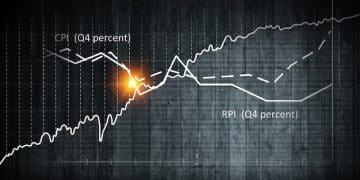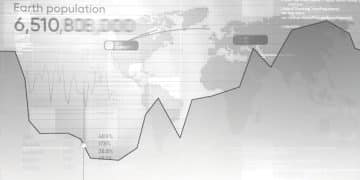CBO Revises US Economic Growth Forecast for Next 5 Years: What It Means

The Congressional Budget Office has updated its economic growth forecasts for the next five years, signaling potential shifts in fiscal policy, budgetary implications, and investment strategies in response to evolving economic data, inflation trends, and labor market dynamics, impacting various sectors of the U.S. economy.
In a significant development for economic observers and policymakers, the Congressional Budget Office revises US economic growth forecast for next 5 years, offering an updated outlook on the nation’s financial trajectory. This revision carries substantial weight, influencing everything from federal budget planning to market expectations and individual financial decisions. Understanding the nuances of these updated projections is crucial for anyone keen on grasping the evolving economic landscape and its potential implications for the future.
Understanding the CBO’s Role and Its Latest Projections
The Congressional Budget Office (CBO) serves as a non-partisan agency providing economic data and analysis to the U.S. Congress. Its forecasts are vital tools for lawmakers as they craft legislation, debate spending, and assess the nation’s fiscal health. The CBO’s recent revision of the U.S. economic growth forecast for the next five years isn’t just an academic exercise; it’s a foundational piece of information that can reshape budgetary priorities and economic strategies across the board.
These projections are not static. They are subject to continuous re-evaluation based on incoming economic data, global events, and shifts in policy. The latest update reflects the CBO’s interpretation of current economic trends and their anticipated trajectory over the medium term. This continuous recalibration ensures that policy discussions are grounded in the most up-to-date and rigorous analysis available.
Key Factors Influencing the Revision
Several critical factors typically drive CBO forecast revisions. These generally include changes in inflation expectations, labor market performance, consumer spending habits, business investment trends, and global economic conditions. Each of these elements plays a significant role in shaping the overall economic outlook, and a shift in any one of them can necessitate a recalibration of the CBO’s projections.
- Inflationary Pressures: Persistent or receding inflationary trends can significantly alter real growth projections.
- Labor Market Dynamics: The strength and growth of the workforce directly impact potential economic output.
- Geopolitical Developments: Global conflicts or trade disputes can introduce volatility and uncertainty.
- Technological Advancements: Innovation can boost productivity and long-term growth potential.
The intricate interplay of these factors means that economic forecasting is less about predicting the future with certainty and more about providing a plausible range of outcomes based on current information and established economic models. The CBO’s revised forecast offers the most informed perspective available given the present confluence of economic forces.
Ultimately, these updated forecasts provide a critical benchmark for stakeholders. From financial markets adjusting investment strategies to businesses planning expansion, and indeed, individual households making long-term financial plans, understanding the CBO’s revised outlook is a gateway to making more informed decisions.
Detailed Analysis of the Updated Growth Figures
When the CBO updates its economic growth forecasts, the detailed figures provide a granular view of their expectations across various economic indicators. These aren’t merely headline numbers; they encompass projections for Gross Domestic Product (GDP), inflation rates, unemployment figures, and interest rates. Each of these components offers insights into different facets of the economy, and their collective movement paints a comprehensive picture of the anticipated economic environment over the next half-decade.
The report likely delineates both nominal and real GDP growth, with the latter adjusting for inflation to provide a clearer measure of economic output. Understanding the distinction is crucial, as high nominal growth driven purely by inflation doesn’t necessarily translate to improved living standards or greater prosperity. The CBO’s expertise lies in dissecting these elements to offer a balanced perspective.
Dissecting GDP, Inflation, and Unemployment Projections
The CBO’s latest figures often reflect evolving dynamics. For instance, if inflation proves more stubborn than previously anticipated, the CBO might revise down real GDP growth even if nominal growth holds steady. Conversely, stronger-than-expected productivity gains could lead to higher real GDP projections without necessarily fueling inflation. Unemployment rates are another key metric; lower projected unemployment can signal a robust labor market, while higher rates could indicate a slowdown.
- GDP Growth: Revised figures will indicate whether the CBO anticipates a faster or slower expansion of the economy.
- Inflation Rates: New projections will show the CBO’s view on the persistence or moderation of price increases.
- Unemployment Outlook: Changes here reflect expectations for labor market tightness and job creation.
- Interest Rates: The CBO also forecasts interest rates, which are critical for borrowing costs and investment.
These detailed projections are not isolated but interconnected. A higher interest rate forecast, for example, might dampen investment and consumer spending, subsequently affecting GDP growth. Similarly, a tight labor market could put upward pressure on wages, potentially influencing inflation trends. The CBO’s model attempts to capture these complex interactions to provide a coherent and integrated forecast.
For investors, businesses, and individuals, these updated figures serve as vital signals. They inform decisions ranging from long-term capital investments to personal financial planning. The nuances within these numbers, beyond the top-line percentages, often hold the most significant implications for specific sectors and financial strategies.
Implications for Federal Budget and Fiscal Policy
The Congressional Budget Office’s revised economic growth forecast holds profound implications for the federal budget and the direction of fiscal policy. These updated projections directly influence estimates of government revenues, driven largely by tax collections, and expenditures, which are affected by economic conditions in myriad ways. A stronger or weaker economic outlook can significantly alter the nation’s fiscal trajectory, impacting everything from the national debt to the funding available for critical social programs and infrastructure projects.
For example, a more optimistic growth forecast might suggest higher tax revenues as incomes rise and economic activity expands, potentially easing pressure on the national debt. Conversely, a downward revision could imply lower revenues and increased demand for certain social safety nets, exacerbating budgetary deficits. These shifts compel policymakers to reconsider existing budgetary frameworks and potentially adjust spending or taxation policies to align with the new economic reality.
Responding to Economic Shifts with Policy Adjustments
The CBO’s forecasts provide a crucial baseline for fiscal policy discussions in Congress. Lawmakers often use these projections to inform debates about spending limits, tax reforms, and the overall size and scope of government. When forecasts change, it can trigger reviews of current policies and potentially lead to new legislative initiatives aimed at either stimulating growth or consolidating government finances.
- Revenue Projections: Higher growth usually translates to increased tax receipts, while lower growth can mean shortfalls.
- Spending Pressures: Economic downturns may increase demand for unemployment benefits and other social programs.
- Debt Management: Growth forecasts influence the projected path of the national debt relative to GDP.
- Policy Debates: Revised forecasts often fuel debates on the necessity and timing of new fiscal interventions.
The interplay between economic forecasts and fiscal policy is dynamic. It is not uncommon for unexpected economic developments, reflected in CBO revisions, to necessitate a re-evaluation of prior legislative commitments or proposed budgetary measures. This constant adaptation underscores the importance of having accurate and unbiased economic analysis readily available to policymakers.
Ultimately, the CBO’s revised forecast serves as a critical compass for navigation through the complex waters of federal finance. It helps ensure that fiscal policy decisions are made with the most comprehensive understanding of the economic environment, aiming to foster stability and sustainable growth while managing the nation’s financial obligations responsibly.

Impact on Financial Markets and Investment Strategies
The release of updated economic forecasts by the Congressional Budget Office often sends ripples through financial markets. Investors, analysts, and traders closely scrutinize these revisions for clues about future interest rates, corporate earnings, and overall economic stability. A revised growth outlook can significantly influence asset valuations, prompting shifts in investment strategies across different sectors and asset classes. The market’s reaction, whether immediate or gradual, reflects its collective interpretation of how these new projections will impact corporate profitability and investor sentiment.
For instance, an upward revision in growth could signal a stronger earnings environment, potentially boosting equity markets. Conversely, a downward revision might lead to defensive positioning, with investors favoring more stable assets or those less sensitive to economic cycles. Bond markets are also highly responsive, as growth and inflation expectations directly influence bond yields and the perceived risk of government debt.
Navigating Market Responses and Portfolio Adjustments
Investors frequently adjust their portfolios in anticipation of or in response to significant economic data. The CBO’s forecasts provide a long-term lens, encouraging a more strategic approach rather than day-to-day tactical shifts. Understanding how different asset classes are poised to perform under the CBO’s revised economic scenario is key to effective portfolio management.
- Equity Markets: Sectors like technology or consumer discretionary could see varied impacts based on growth forecasts.
- Fixed Income: Bond yields typically react to changes in inflation and interest rate expectations.
- Real Estate: Property markets can be influenced by long-term interest rates and economic expansion, affecting demand and pricing.
- Commodities: Prices of industrial inputs and raw materials often correlate with overall economic activity.
The CBO’s projections also inform central bank decisions, particularly concerning monetary policy. While the CBO is non-partisan and distinct from the Federal Reserve, its economic outlook provides context for the Fed’s evaluation of inflation and employment goals. Any perceived shift in the Fed’s stance, influenced by broader economic data including CBO forecasts, can have a profound impact on market liquidity and investor behavior.
Ultimately, the revised CBO forecast serves as an important data point in a complex matrix that shapes financial market behavior. It encourages investors to reassess their assumptions and calibrate their strategies to align with the anticipated economic environment, striving to optimize returns and manage risk effectively.
Potential Risks and Opportunities Elevated by the CBO Update
Any economic forecast, no matter how meticulously crafted, comes with inherent risks and uncertainties. The Congressional Budget Office’s revised outlook for the next five years is no exception. While the projections offer a baseline for planning, a range of domestic and global factors could deviate from these predicted paths, presenting both unforeseen challenges and new opportunities. Understanding these potential externalities is crucial for robust strategic planning across government, business, and individual financial management.
For example, global geopolitical events, such as conflicts or trade disputes, can swiftly alter supply chains and commodity prices, directly impacting domestic inflation and growth. Similarly, the pace of technological innovation or unexpected demographic shifts could lead to either higher productivity gains or new workforce challenges not fully captured in current models. These “known unknowns” and “unknown unknowns” are always present, underscoring the need for adaptive strategies.
Navigating Economic Headwinds and Tailwinds
The CBO’s revised forecast implicitly highlights areas where the economy might be particularly vulnerable or, conversely, where it could experience unexpected acceleration. Recognizing these potential headwinds and tailwinds allows for proactive measures rather than reactive adjustments. Businesses might identify new market niches, while governments might pinpoint areas for targeted investment or regulatory adjustments.
- Inflation Resilience: The risk of persistent inflation versus the opportunity for its faster moderation.
- Labor Market Flexibility: The ability of the workforce to adapt to technological change versus potential skill gaps.
- Supply Chain Stability: Vulnerabilities to global disruptions versus opportunities for domestic reshoring.
- Fiscal Health: Risks of escalating debt versus opportunities for sustainable budget management.
On the opportunity side, a generally stable or improving outlook could embolden businesses to increase investment in research and development, fostering innovation and long-term competitiveness. It could also encourage foreign direct investment into the U.S., leveraging perceived economic stability. For individuals, an optimistic outlook might provide greater confidence in making significant financial commitments, such as home purchases or long-term savings plans.
Conversely, a more cautious outlook might prompt businesses to streamline operations and diversify their risk exposure. Governments might prioritize fiscal consolidation to bolster resilience against future shocks. Individuals might focus on building stronger emergency savings and diversifying their investments to withstand potential downturns.
Ultimately, the CBO’s revised forecast, while providing a valuable compass, also serves as a reminder that economic conditions are dynamic and subject to a multitude of influences. Acknowledging and preparing for both the risks and opportunities it illuminates is a cornerstone of effective economic stewardship.

Broader Economic Context and Future Outlook
Analyzing the Congressional Budget Office’s updated forecast for U.S. economic growth over the next five years requires understanding it within a broader economic context. The U.S. economy, like any major global player, is intricately linked to international trade flows, global political stability, and the economic performance of its key partners. Therefore, the CBO’s domestic projections are always a function of, and contributor to, this larger global economic narrative.
The revised numbers are not merely a snapshot in time; they are a forward-looking assessment, a best estimate of what lies ahead given current information. Factors such as demographic shifts, the pace of climate change adaptation, and the persistent evolution of technology are long-term structural considerations that subtly influence medium-term forecasts. These background forces shape the underlying potential of the economy, even as more immediate cyclical factors primarily drive annual variations.
Looking Beyond Five Years: Long-Term Trends
While the CBO’s specific focus in this revision is the next five years, the agency also produces longer-term projections that extend a decade or more. These long-term outlooks often highlight structural challenges or opportunities that may not be fully apparent in the shorter-term forecast but build gradually over time. Examples include the sustainability of entitlement programs, the implications of an aging population, and the long-run federal debt trajectory.
- Global Economic Interconnectedness: How U.S. growth influences and is influenced by international markets.
- Demographic Shifts: The long-term impact of population aging on workforce participation and consumption.
- Climate Change Adaptation: Economic costs and opportunities associated with transitioning to a greener economy.
- Technological Disruption: The ongoing effects of AI and automation on productivity and employment.
The CBO’s work provides a comprehensive, if not exhaustive, picture of these ongoing trends. Their analyses often serve as foundational documents for bipartisan dialogues on how to address long-term fiscal and economic challenges. The five-year forecast acts as a critical checkpoint, providing updated data that feeds into these larger discussions.
In essence, the revised CBO forecast encourages a holistic view of the economy. It prompts reflection not only on immediate policy responses but also on how the nation can position itself for sustained prosperity amidst evolving global and domestic conditions. It is a call to recognize the dynamic nature of economic forces and to plan with foresight and adaptability.
Navigating Uncertainty with CBO’s Updated Guidance
In an economic environment characterized by persistent shifts and unforeseen events, having reliable and impartial data is paramount. The Congressional Budget Office’s updated U.S. economic growth forecast for the next five years serves precisely this purpose. It provides a consistent, non-partisan assessment that helps stakeholders across various sectors make more informed decisions. While no forecast can eliminate uncertainty, the CBO’s rigorous methodology and transparency provide a vital framework for understanding potential economic pathways.
The CBO continuously refines its models and incorporates the latest economic data, ensuring its projections remain as accurate and relevant as possible. This commitment to ongoing evaluation means that their updates are not just numbers, but reflections of a dynamic analysis process that adapts to new information. For anyone relying on these forecasts, this iterative improvement builds trust and utility.
The Role of Independent Analysis in Policy and Planning
The CBO’s independence is one of its most valuable attributes. Free from political influence, its analyses are trusted by both sides of the aisle, serving as a common ground for discussing complex economic challenges. This neutrality is particularly critical when the economic outlook shifts, as it ensures that policy debates are grounded in objective data, rather than partisan interpretations.
- Non-partisan Reliability: CBO’s independent status ensures unbiased economic analysis.
- Data-Driven Decisions: Forecasts provide a basis for evidence-based policy formulation.
- Long-term Vision: Helps stakeholders align short-term actions with long-term economic goals.
- Transparency: Detailed reports allow for scrutiny and understanding of the underlying assumptions.
For businesses, the CBO’s guidance can influence investment decisions, hiring plans, and strategic market positioning. For individuals, it can inform decisions about savings, career paths, and significant purchases. And for policymakers, it is an indispensable tool in crafting legislation that is responsive to the nation’s economic realities and future challenges.
Ultimately, the CBO’s updated forecast is more than just a set of numbers; it’s a critical resource that illuminates the path forward. By leveraging this expert guidance, the nation can better navigate economic complexities, mitigate risks, and seize opportunities, working towards a more stable and prosperous future.
| Key Metric | Brief Description of Change |
|---|---|
| 📈 GDP Growth | Revised projections for U.S. economic output, reflecting updated data and trends. |
| 💸 Inflation Outlook | New forecasts for consumer price changes, impacting purchasing power. |
| 📊 Fiscal Impacts | Direct effects on federal revenues and expenditures, influencing budget debates. |
| 💼 Market Repercussions | Potential shifts in investment strategies and market valuations stemming from the forecast. |
Frequently Asked Questions
The CBO is a non-partisan agency providing economic and budgetary analysis to the U.S. Congress. Its primary role is to furnish objective, independent analysis to aid congressional budget and economic policy decisions, promoting greater transparency and informed debate.
The CBO revises its forecasts regularly to incorporate new economic data, changes in laws, and evolving understanding of economic trends. This iterative process ensures their projections reflect the most current information and the latest economic modeling, providing up-to-date guidance.
CBO forecasts directly influence estimates of federal revenues and expenditures. A stronger economic outlook might project higher tax revenues, while a weaker one could signal increased spending on social safety nets, directly shaping budgetary debates and policy choices.
The CBO’s forecasts typically include projections for Gross Domestic Product (GDP), inflation rates, unemployment rates, and interest rates. These indicators provide a comprehensive view of the CBO’s anticipated economic conditions and influence various sectors.
Financial markets often react by adjusting asset valuations, bond yields, and investment strategies. An upward revision might boost equity markets, while a downward one could spark defensive positioning, as investors reassess future corporate earnings and economic stability.
Conclusion
The Congressional Budget Office’s decision to revise its U.S. economic growth forecast for the next five years marks a pivotal update for all stakeholders navigating the nation’s financial landscape. These comprehensive projections extend beyond mere numbers, offering a robust, non-partisan foundation for understanding future economic trends, informing fiscal policy, and guiding investment decisions. By meticulously analyzing GDP, inflation, unemployment, and interest rate outlooks, the CBO provides critical clarity in an ever-evolving economic environment. The implications resonate deeply, influencing everything from federal budget allocations and debt management to the strategic positioning of businesses and the financial planning of individual households. Ultimately, this updated guidance underscores the imperative of adaptability and informed decision-making in harnessing opportunities and mitigating risks associated with the unfolding economic narrative. Embracing this expert analysis is key to fostering a resilient and prosperous future.





